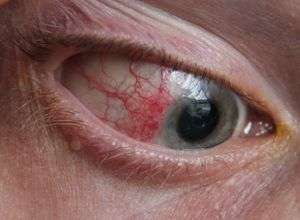Episcleritis
Background
- Abrupt onset of inflammation in the episclera
- 70% of cases occurs in women (usually young/middle-aged)
- Usually a benign, self-limited condition
- Can be classified into simple (more common) or nodular types
- Most commonly idiopathic but may occur as an ocular manifestation of underlying autoimmune conditions eg RA, IBD
- Also associated with glaucoma and cataracts[1]
Clinical Features

Episcleritis
History
- Abrupt onset of redness, irritation, and watering of the eye
- Pain is unusual
- Vision unaffected
- 50% of cases are bilateral
Physical exam
- Vasodilatation of the superficial episcleral vessels
- Focal area(s) of redness
- May have a tender scleral nodule (nodular episcleritis)
Differential Diagnosis
Unilateral red eye
- Acute angle-closure glaucoma^
- Anterior uveitis
- Conjunctivitis
- Corneal erosion
- Corneal ulcer^
- Endophthalmitis^
- Episcleritis
- Herpes zoster ophthalmicus
- Inflamed pinguecula
- Inflamed pterygium
- Keratoconjunctivitis
- Keratoconus
- Nontraumatic iritis
- Scleritis^
- Subconjunctival hemorrhage
- Orbital trauma
^Emergent diagnoses
^^Critical diagnoses
Evaluation
- Must distinguish from scleritis
- Scleritis likely to have pain and decreased vision
- Use of 2.5% phenylephrine drops will cause vasoconstriction/blanching of episcleral but not scleral vessels. Thus, there will be decreased injection and redness in episcleritis but not scleritis.[2]
- Red area will be mobile if moved with a moist q-tip
- Must distinguish from conjunctivitis
- Episcleritis will usually have a sectoral pattern of injection, as opposed to a diffuse injection seen in conjunctivitis.
Management
- Topical lubricants
- Artificial tears q4-6hr
- Oral NSAIDs
- Topical steroids may relieve symptoms but are associated with rebound redness and potentially worse future events and are generally not recommended[3]
Disposition
- Refer to ophtho is unsure of diagnosis or if steroids are necessary for treatment
- Self-limiting (will resolve within 2-3 weeks)
See Also
External Links
References
- Honik G, Wong IG, Gritz DC; Incidence and prevalence of episcleritis and scleritis in Northern California. Cornea. 2013 Dec;32(12):1562
- Mahmood AR, Narang AT. Diagnosis and management of the acute red eye. Emerg Med Clin North Am 2008; 26:35-55.
- Akpek EK, Uy H, Christen W, et al. Severity of episcleritis and systemic disease association. Ophthalmology. 1999;106:729.
This article is issued from
Wikem.
The text is licensed under Creative
Commons - Attribution - Sharealike.
Additional terms may apply for the media files.